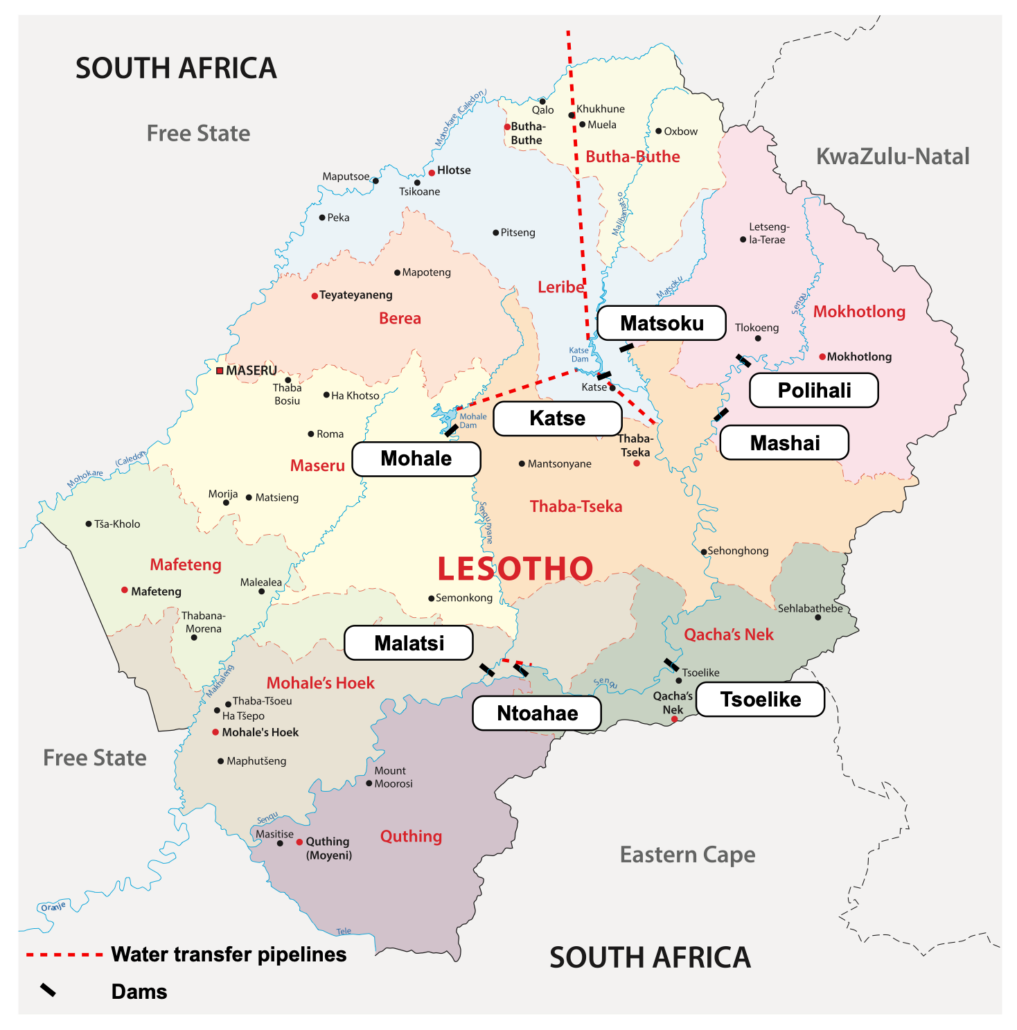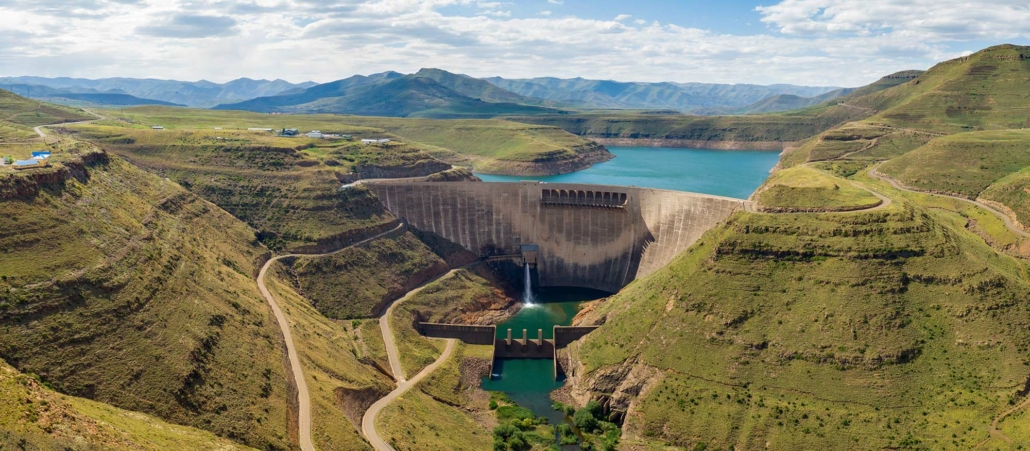Lesotho Large-scale Water Transfer Scheme Case Study
Lesotho is a landlocked country within the interior of South Africa, in southern Africa. It is distinguished by its mountainous topography and status as the only nation to be entirely above 1,000 meters in elevation. Its capital and largest city is Maseru. Lesotho is also known as the “Kingdom in the Sky” due to its high altitude—it has the highest lowest point of any country in the world. The country has a constitutional monarchy and gained independence from Britain in 1966.
The country experiences high poverty levels and struggles to feed its growing population. Most farms are subsistence, and productivity is low. It is economically dependent on South Africa.
Lesotho is a low-income country (LIC) and several problems limit the country’s development:
- The country faces frequent dry spells, leading to droughts and food shortages. This can cause famine.
- Lesotho’s government and politics are still developing, which impacts the economy’s growth. Lesotho is one of the worst countries in the world for wealth inequality. Some profit from diamond mining, whereas others remain unemployed and impoverished.
To address these inequalities, the government decided in 2004 to trade surplus water with neighbouring South Africa to improve its economy and development.
What is the Lesotho Highland Water Project?
The Lesotho Highlands Water Project (LHWP) is a large-scale water transfer scheme where water is diverted from the highlands of Lesotho to South Africa’s Free State and the greater Johannesburg area, which desperately needs water. This is mainly due to these regions’ rapidly growing population and industrial demands.
The project includes the construction of dams, reservoirs, and tunnels designed to capture the headwaters of the Senqu/Orange River in Lesotho and transfer it to South Africa.
On completion, 40 per cent of the water from the Segu (Orange) River in Lesotho will be transferred to the River Vaal in South Africa. The scheme is expected to take 30 years to complete.
The main features of the scheme include:
- The Katse and Mohale Dams (completed in 1998 and 2002) store water transferred through a tunnel to the Mohale Reservoir.
- Water is then transported to South Africa through a 32km tunnel, enabling hydroelectric power to be produced at the Muela plant.
- The 165m high Polihali Dam will hold 2.2 billion m3 of water and connect to the Katse Dam by a 38km transfer tunnel.
- The Tsoelike Dam will be built at the confluence of the Tsolike and Senqu Rivers and will store up to 2223 million m3.
- The Ntoahae Dam and pumping station will be built 40km downstream from the Tsoelike Dam on the Senqu River.
When complete, 200km of tunnels will transfer 2000 million m3 of water to South Africa annually.
Why is the Lethoso Highland Water Project needed?:
- South Africa’s Demand: South Africa has an ever-increasing demand for water due to urbanisation, economic growth, and a relatively dry climate.
- Economic Benefits for Lesotho: Lesotho sees this as an opportunity to generate revenue by selling water, which can be used for the country’s development.
- Environmental Conservation: The project provides a clean and sustainable source of water for South Africa
Advantages for Lesotho:
- Economic Development: The project generates significant revenue for Lesotho, boosting its economy. It will provide 75% of its GDP. The income helps develop and improve standards of living.
- Energy production: The scheme will provide Lesotho with all its HEP requirements.
- Job Creation: It has created thousands of jobs for the local population during construction.
- Infrastructure Development: The project has led to the development of infrastructure such as roads and communication networks with access roads built to the construction sites.
- Improved Water Supply: Some areas of Lesotho benefit from improved water supply systems due to the project. Water supply will reach 90% of the population of the capital, Maseru.
- Improved Sanitation: Sanitation coverage will increase from 15% to 20%.
Advantages for South Africa:
- Water Security: It provides a critical water source for South Africa’s industrial heartland.
- Safe Water: Provides safe water for the 10% of the population without access to a safe supply.
- Economic Growth: Water is essential for sustaining economic activity in the Gauteng Province.
- Drought Mitigation: It helps mitigate the effects of periodic droughts in the region. It provides water to an area with an uneven rainfall pattern and regular droughts.
- Ecosystem Improvement: Freshwater reduces the acidity of the Vaal River Reservoir. Water pollution from industry, sewage, and gold mines destroyed the local ecosystem. The influx of fresh water is restoring the balance.
Disadvantages for Lesotho:
- Displacement: Communities have been displaced by the construction of the reservoirs. The construction of the first two dams meant 30000 people had to move from their land. The construction of the Polihali Dam will displace 17 villages and reduce agricultural land for 71 villages.
- Environmental Impact: There has been an impact on local ecosystems, including the destruction of a unique wetland, due to the control of regular flooding downstream of the dams.
- Corruption: Corruption has prevented money and investment from reaching those affected by the construction.
- Dependency: An over-reliance on revenues from water sales to South Africa may make Lesotho economically vulnerable.
Disadvantages for South Africa:
- Cost: The water cost is significant and must be borne by the South African government and, ultimately, the consumers. Costs are likely to reach US$4 billion.
- Leakages: 40% of water is lost due to leaks.
- Inequality: The increased water tariffs for the scheme are too high for the poorest people.
- Political Dependence: There is a reliance on Lesotho for a critical resource, which could lead to political challenges.
- Potential for Conflict: As water becomes an increasingly scarce resource, the potential for conflict over water rights could arise.
The LHWP is an example of a transboundary water resource management project with complex implications for both nations. It’s a balancing act between meeting the water needs of a growing population and economy in South Africa and managing the socio-economic and environmental impacts on Lesotho.
Despite the project not being complete, the Lesotho government has agreed to develop a second transfer scheme with Botswana. This could lead to an increase in Lesotho’s economic and political power in the future.
Summary
Flashcards
Check Your Knowledge
Coming soon
Test Yourself
Resource Management
Menu coming soon


